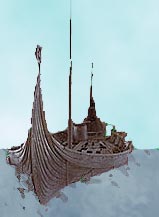Who were the Vikings?
Roots
In terms of English history, "Viking" normally refers to the Scandinavian warriors and traders who carried out raids across much of Northern Europe, from the last years of the 8th century until halfway through the 11th century. However, it is hard to distinguish Vikings from the Saxons and Normans whom they fought. They were all North Germanic/Scandinavian tribes. (King Harald was descended from Danish Vikings for instance. The "Normans" were so-called by the fact of being descendants of Norsemen). It is therefore hard to accept the time boundaries of the Viking era as being anything other than a rough guide to the time of the greatest number of raids.
During this time, the Vikings travelled almost unbelievable distances, even reaching Baghdad and possibly Newfoundland. Although all Scandinavian Viking tribes shared a very similar language and culture, it is possible to distinguish their destinations in terms of today's national groupings. Norwegians travelled to the north and west, to Scotland, Iceland, and Greenland. The Danish went to England and France and the Swedish went to Northern Russia.
Culture
Both Saxons and Vikings shared similar beliefs and culture. Their gods were the pantheon headed by Odin, who was also worshipped, under the name of Wotan by the Saxons.Their technological triumph was their naval technology. Their vessels were of two main kinds - the longship and the cargo vessel, the knarr.
 The longship reached its peak of development in the 9th century. It was a long, narrow and shallow rowing boat. Because it was so shallow, it could be used in coastal water and rivers that would destroy a deeper vessel. It could be used effectively in water that was only a metre deep. Its shape was optimised for speed. In later years, a square shaped woollen sail was used, particularly on long journeys, to supplement the effort of the oarsmen. No sails have been found, although there are several examples of Viking longships in existence, many of which survive from burials. The ships show very high quality of workmanship. They often include very finely carved figureheads. Several modern replicas have been made.
The longship reached its peak of development in the 9th century. It was a long, narrow and shallow rowing boat. Because it was so shallow, it could be used in coastal water and rivers that would destroy a deeper vessel. It could be used effectively in water that was only a metre deep. Its shape was optimised for speed. In later years, a square shaped woollen sail was used, particularly on long journeys, to supplement the effort of the oarsmen. No sails have been found, although there are several examples of Viking longships in existence, many of which survive from burials. The ships show very high quality of workmanship. They often include very finely carved figureheads. Several modern replicas have been made.
Viking navigational skills were highly advanced and they had a range of techniques and instruments for determining their location. These may have included a form of astrolabe and a compass, as well as such resourceful ideas as taking a caged crow and releasing it to find land.
References and Further Reading
- Wikipedia on longship
- Oslo University Viking Ship Museum
- Saxons and Vikings - The Pitkin Guide, ISBN 1841650420